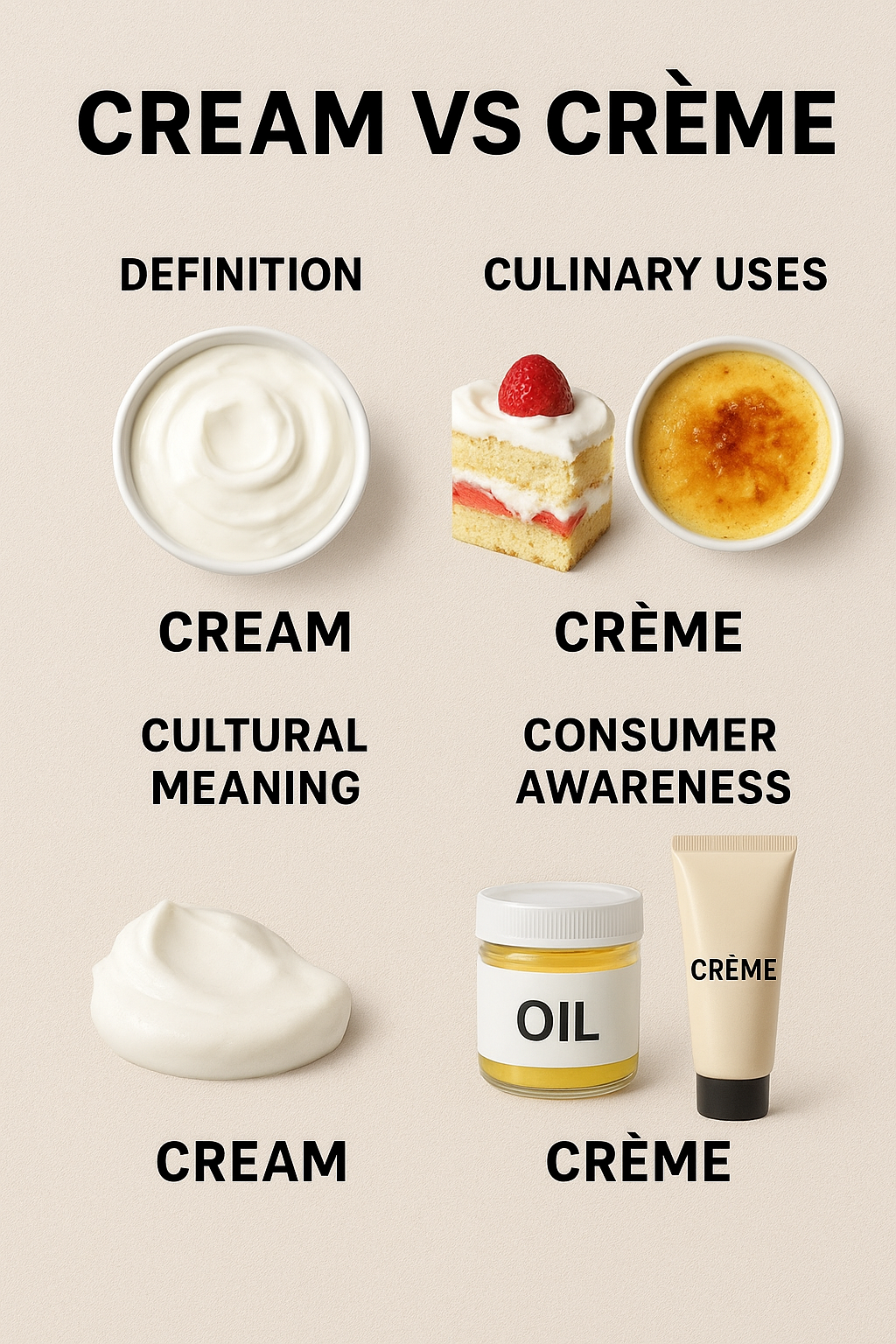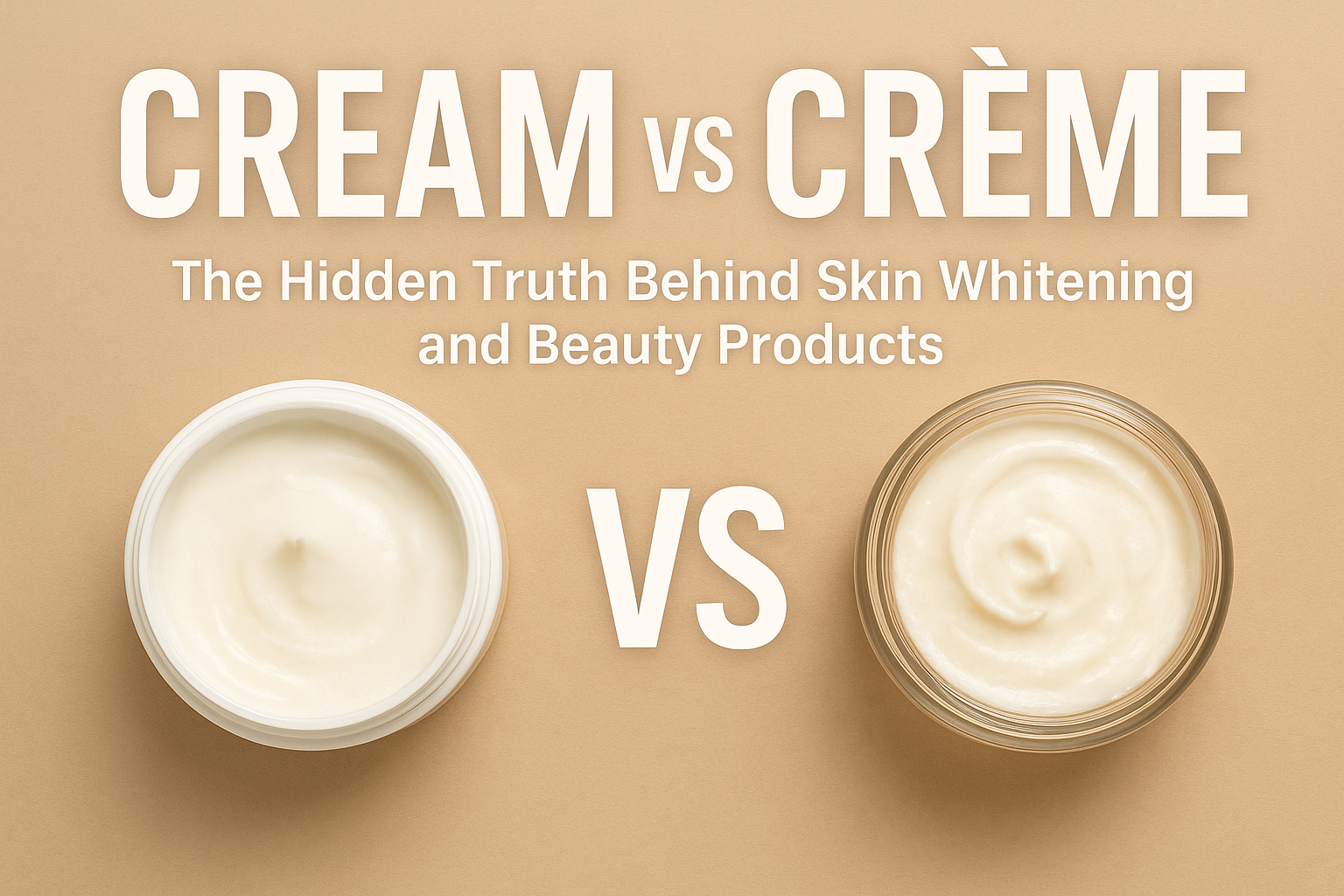Cream vs Crème: Meaning, Usage, and Detailed Comparison
Language can often surprise us with words that look almost identical but have different meanings, pronunciations, and cultural contexts. One such example is the pair "cream" and "crème". While they may appear similar, the two words come from different linguistic roots and are used in distinct ways across English and French contexts.
This article explores the complete difference between cream and crème — including their meanings, origins, pronunciation, grammatical usage, and how they appear in daily language, food items, and branding. By the end, you’ll have a clear understanding of when to use each term correctly.
1. Introduction to the Terms
The word cream is widely known in English-speaking countries. It usually refers to the thick, fatty part of milk that rises to the top when milk is left to stand. It’s also used for skincare, desserts, and even color descriptions.
On the other hand, crème is a French word that literally translates to “cream” in English. However, in English usage, the word crème is generally reserved for describing specific French-style dishes or products that borrow from French culinary or cultural contexts — for example, crème brûlée or crème fraîche.
2. Basic Meaning of “Cream”
In English, cream has several meanings depending on context:
- Food: The rich, fatty part of milk used in cooking and baking (e.g., “fresh cream,” “whipped cream”).
- Cosmetics: A thick liquid or semi-solid substance used for skincare (e.g., “moisturizing cream”).
- Color: A pale yellowish-white color resembling dairy cream.
- Idioms: It can also mean “the best of something,” as in the phrase “the cream of the crop.”
3. Basic Meaning of “Crème”
The word crème is borrowed directly from French. It is pronounced as “krem” and used mainly in reference to foods and products with French origins or influences. In many cases, “crème” indicates a richer, more luxurious, or traditional French-style preparation.
- In Food: Seen in dishes like crème brûlée (a dessert made with custard and caramelized sugar) or crème anglaise (a thin custard sauce).
- In Beauty Products: Used to give a French or premium touch, such as “anti-aging crème.”
- In Branding: Many brands use the accent mark to imply sophistication or luxury.
4. The Etymology: Where These Words Come From
Both words — cream and crème — share a common Latin origin from the word “chrisma” or “cresma”, meaning “ointment” or “thick layer.” The term evolved through Old French as “cresme”, which later became crème in modern French.
When the word entered Middle English, it became “creme” and eventually “cream,” losing the accent mark and adapting to English phonetics. This change reflected English’s tendency to simplify foreign spellings while retaining the meaning.
5. Visual and Pronunciation Difference
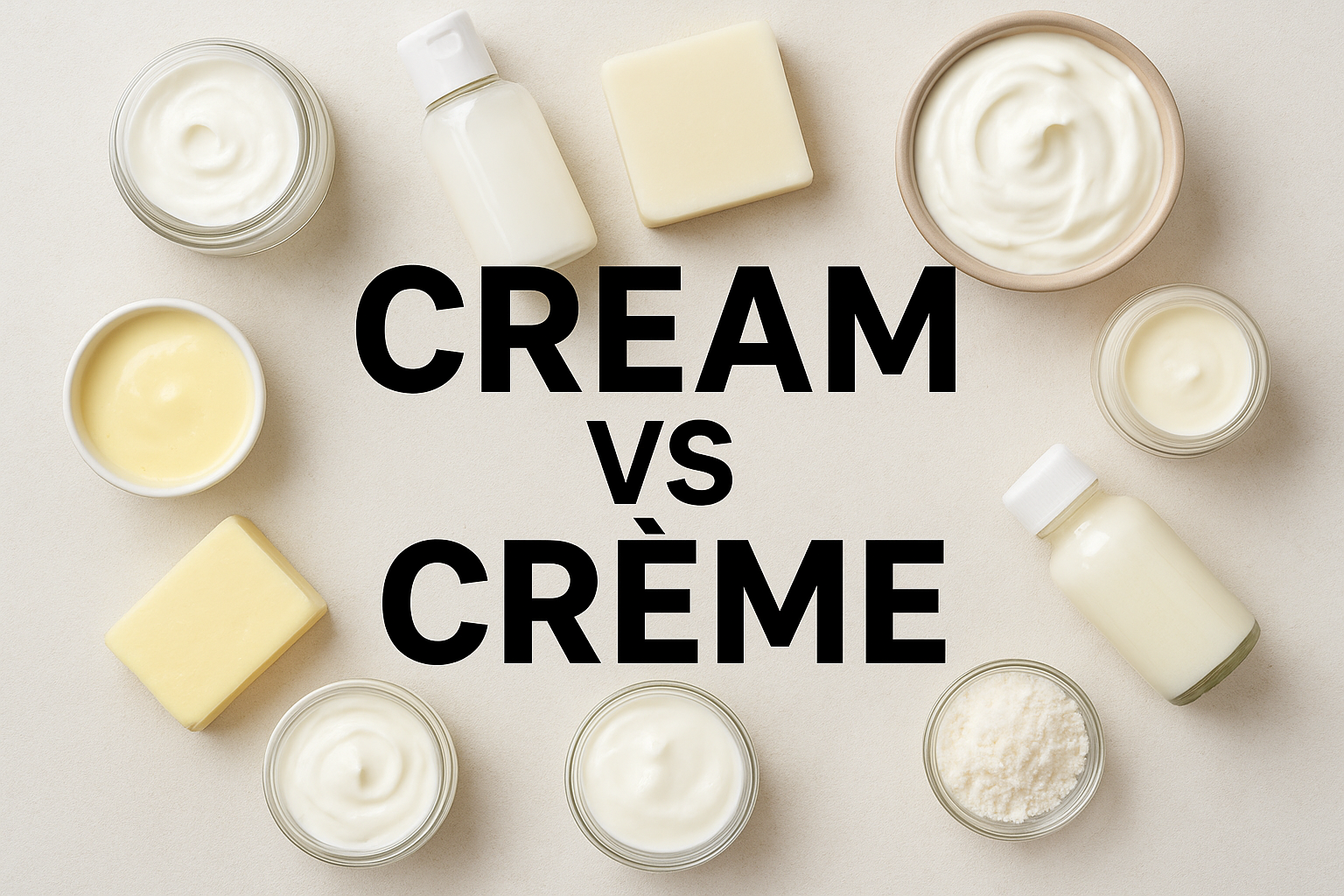
The two words look similar, but the small accent mark over the “e” in crème (called an accent grave) changes both its pronunciation and its perceived meaning.
- Cream: Pronounced as /kriːm/ — a long “ee” sound.
- Crème: Pronounced as /krɛm/ — a short “e” sound, similar to the word “them.”
This pronunciation difference helps in distinguishing between the English and French versions, especially in culinary or luxury product contexts.
6. The Influence of Language in Marketing
Language plays a powerful role in marketing, especially when it comes to beauty and luxury products. The addition of a small accent mark in a word can make it sound more elegant, foreign, or premium. This is exactly what happens with the term “crème.”
In modern advertising, the word crème is often used by skincare, cosmetic, and food brands to create a sense of luxury, sophistication, and quality. The accent makes the product appear as if it has French origins — and since France is globally known for high-end beauty products and culinary excellence, consumers are more likely to trust it.
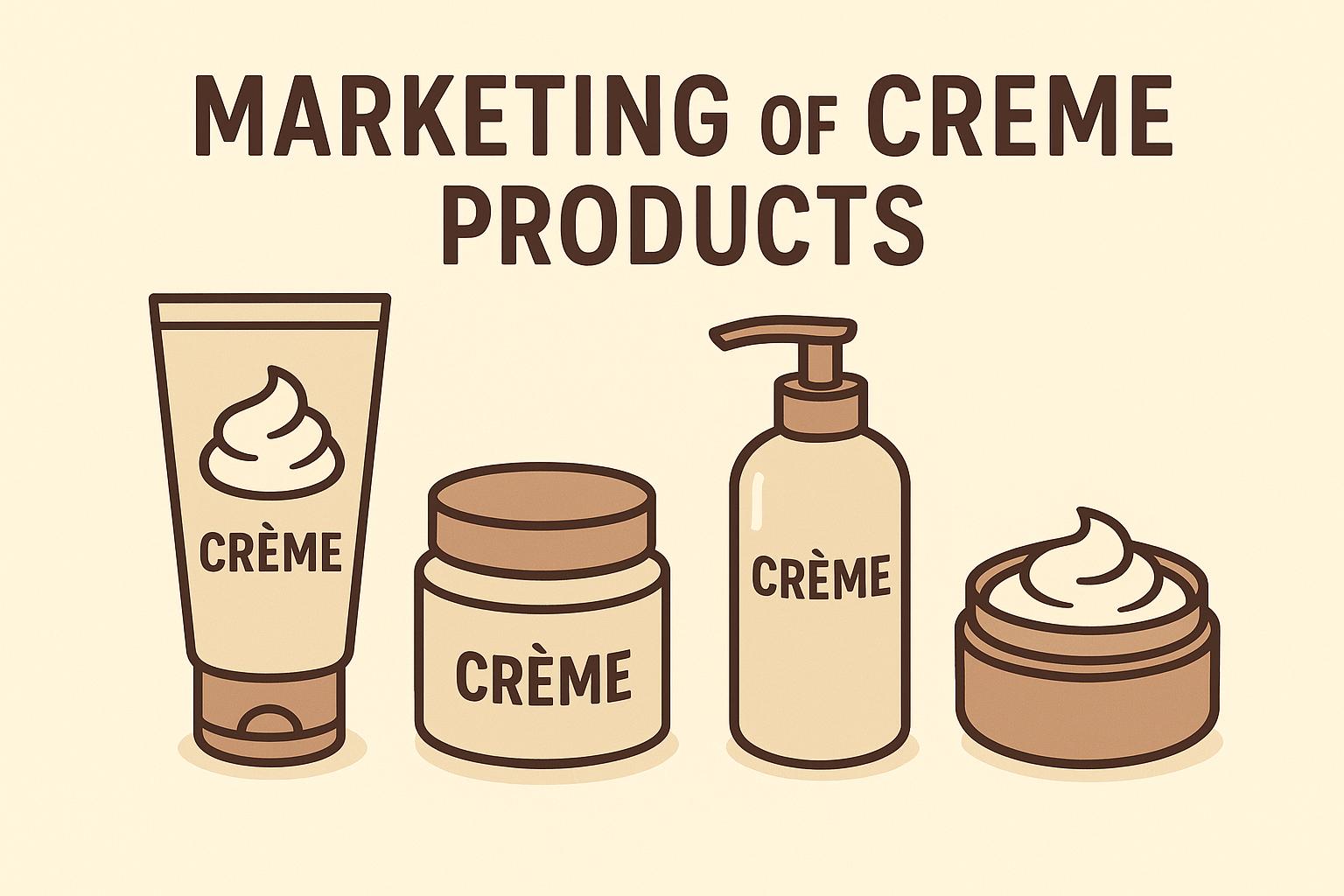
However, not every product labeled as “crème” truly lives up to its luxurious name. In many cases, these products are simply regular creams with artificial fragrances, chemical preservatives, and synthetic compounds — sold at a higher price because of branding.
7. How Companies Use “Crème” to Mislead Consumers
The commercial use of the word “crème” has become more of a marketing strategy than a genuine product distinction. Companies often use French words or accents on their packaging to give an impression of superior quality or imported origin — even when the product is entirely manufactured elsewhere.
- Perception of Luxury: The accent in “crème” makes it sound premium and foreign, which psychologically convinces people it must be better or more effective.
- Price Manipulation: Many brands charge a much higher price for products labeled “crème,” although the ingredient composition is similar to cheaper alternatives labeled simply “cream.”
- Ingredient Confusion: Some companies deliberately use complex French or scientific names on ingredient lists to make consumers believe the product contains rare or natural components.
- Packaging Tricks: Glossy boxes, golden fonts, and French-style names (like “Crème Élégance” or “Crème Pure”) are designed to mislead the buyer’s subconscious mind.
This marketing trick is not limited to beauty items. Even food products like “crème-filled biscuits” or “crème desserts” sometimes contain little to no actual dairy cream. Instead, they use vegetable oils, sugar substitutes, and emulsifiers to mimic texture.
8. Harmful Effects of Artificial “Crèmes”
While the term “crème” may sound luxurious, not all such products are safe or beneficial. Many commercial creams marketed as “crème” contain harmful ingredients that can damage the skin or cause health issues over long-term use.
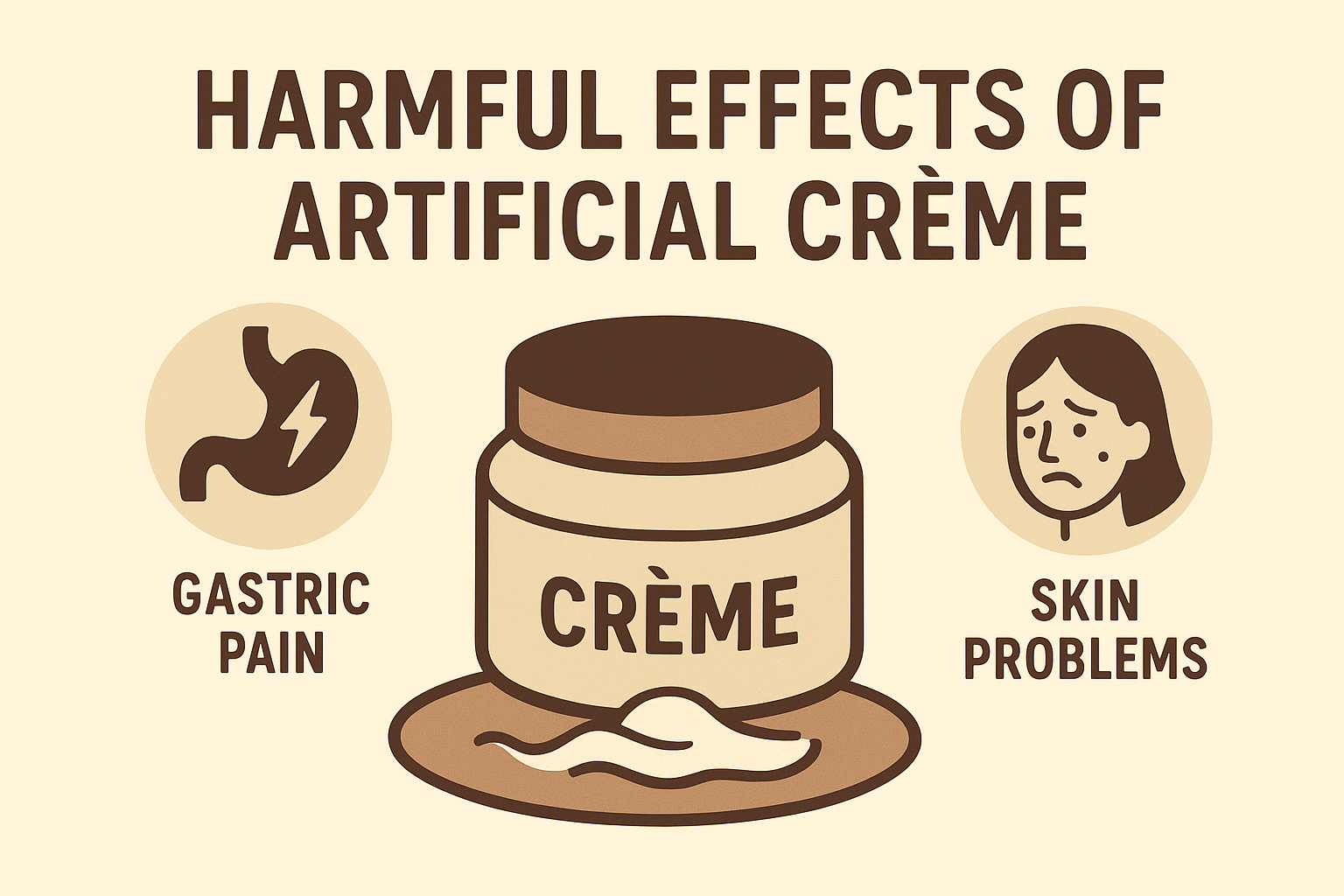
Common Harmful Ingredients Found in Synthetic Crèmes:
- Parabens: Used as preservatives, but linked to hormonal imbalance and skin irritation.
- Petroleum-based compounds: Can block skin pores and trap bacteria, leading to acne or rashes.
- Artificial Fragrances: May trigger allergies, headaches, or respiratory issues for sensitive individuals.
- Alcohol derivatives: Found in “light-feel” creams but often cause skin dryness and damage.
- Bleaching agents (in fairness crèmes): Can cause long-term skin thinning and pigmentation problems.
What makes this more concerning is that many brands disguise these ingredients under French or chemical-sounding names to maintain the illusion of sophistication. Consumers often assume that something written in a foreign or complex style must be premium — but that’s rarely true.
9. Consumer Awareness and Safe Usage Tips
It’s crucial for consumers to be informed and cautious before purchasing any product labeled as “crème.” Whether it’s a cosmetic item or a food product, the label alone doesn’t guarantee authenticity or quality.
- Always read the ingredient list carefully instead of trusting the brand name.
- Check if the product is dermatologically tested and approved by safety authorities.
- Prefer organic, natural, or unscented creams if you have sensitive skin.
- Avoid creams that promise instant whitening or fairness — they often contain dangerous chemicals.
- Be wary of fake “imported” products — French words on packaging don’t mean it’s made in France.
Consumers should also remember that marketing language is not scientific evidence. The effectiveness of a skincare or cosmetic product depends on ingredients, formulation quality, and skin compatibility — not on whether the label says “crème” or “cream.”
10. Understanding the Truth Behind “Luxury” Crèmes
Luxury skincare companies often justify their high prices by emphasizing “rare ingredients” or “innovative formulas.” However, independent studies have shown that many of these premium “crèmes” contain ingredients identical to mid-range or drugstore creams. The difference lies primarily in branding, fragrance, and packaging.
A simple moisturizer with safe, balanced ingredients can often perform just as well — or better — than an expensive crème that prioritizes image over actual skincare value.
11. The Culinary Side of “Cream” and “Crème”
While both “cream” and “crème” have linguistic and marketing differences, their use in the culinary world shows how cultural influences shape food terminology. In English-speaking countries, “cream” usually refers to a dairy product derived from milk, whereas “crème” refers to French-style dishes or preparations that often include cream as an ingredient — but with distinct techniques, textures, and flavors.
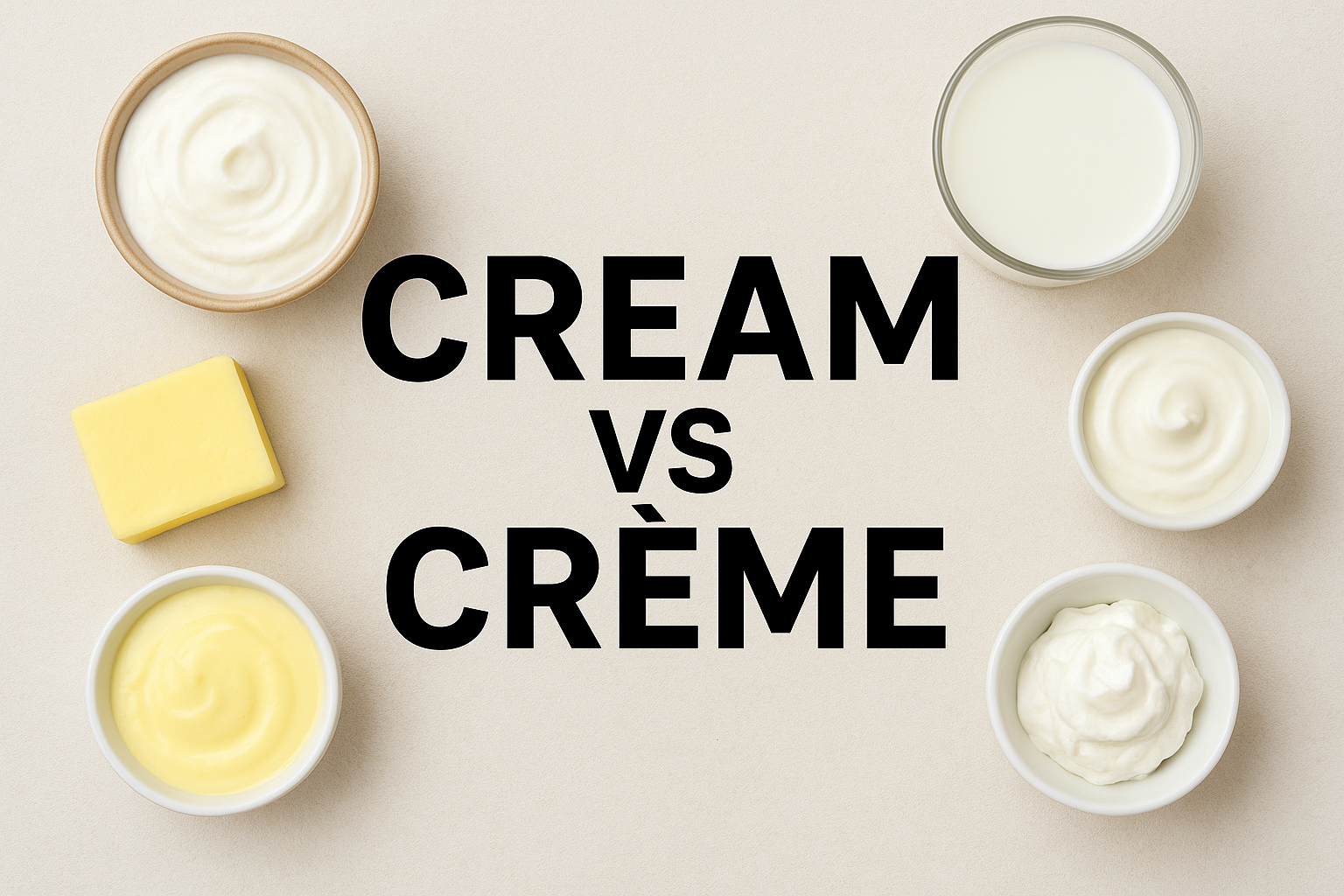
12. Common Culinary Uses of “Cream”
In general English cooking and food terminology, “cream” refers to several types of dairy-based products. These products differ by their fat content and how they are processed. Here are the most common varieties:
- Fresh Cream: A lightly thickened dairy cream used in soups, sauces, and desserts.
- Whipping Cream: Contains around 30–35% fat and can be whipped into a light, airy texture for toppings or desserts.
- Heavy Cream: Richer and thicker than regular cream, used in baking, pasta sauces, and ice creams.
- Sour Cream: Cream that has been fermented slightly to produce a tangy flavor, used in dips or baked potatoes.
- Double Cream: A British term for very thick cream with a high fat content, perfect for pouring or whipping.
The use of cream in cooking enhances flavor, smoothness, and texture. It’s a staple ingredient in cuisines around the world, from creamy pasta sauces to rich desserts like cheesecakes and puddings.
13. Common Culinary Uses of “Crème”
The French word “crème” appears frequently in fine dining, baking, and dessert menus across the globe. It is often used to describe custard-based or cream-based dishes that have a specific preparation method, rather than just the ingredient itself.
Here are some famous dishes that use the term “crème” in their names:
- Crème Brûlée: A creamy custard dessert with a caramelized sugar crust on top — one of the most iconic French desserts.
- Crème Anglaise: A light, vanilla-flavored custard sauce used in many desserts.
- Crème Fraîche: A cultured cream similar to sour cream but less tangy and more buttery.
- Crème Caramel: A custard dessert topped with soft caramel, served chilled.
- Crème Pâtissière (Pastry Cream): A thick custard filling used in éclairs, tarts, and pastries.
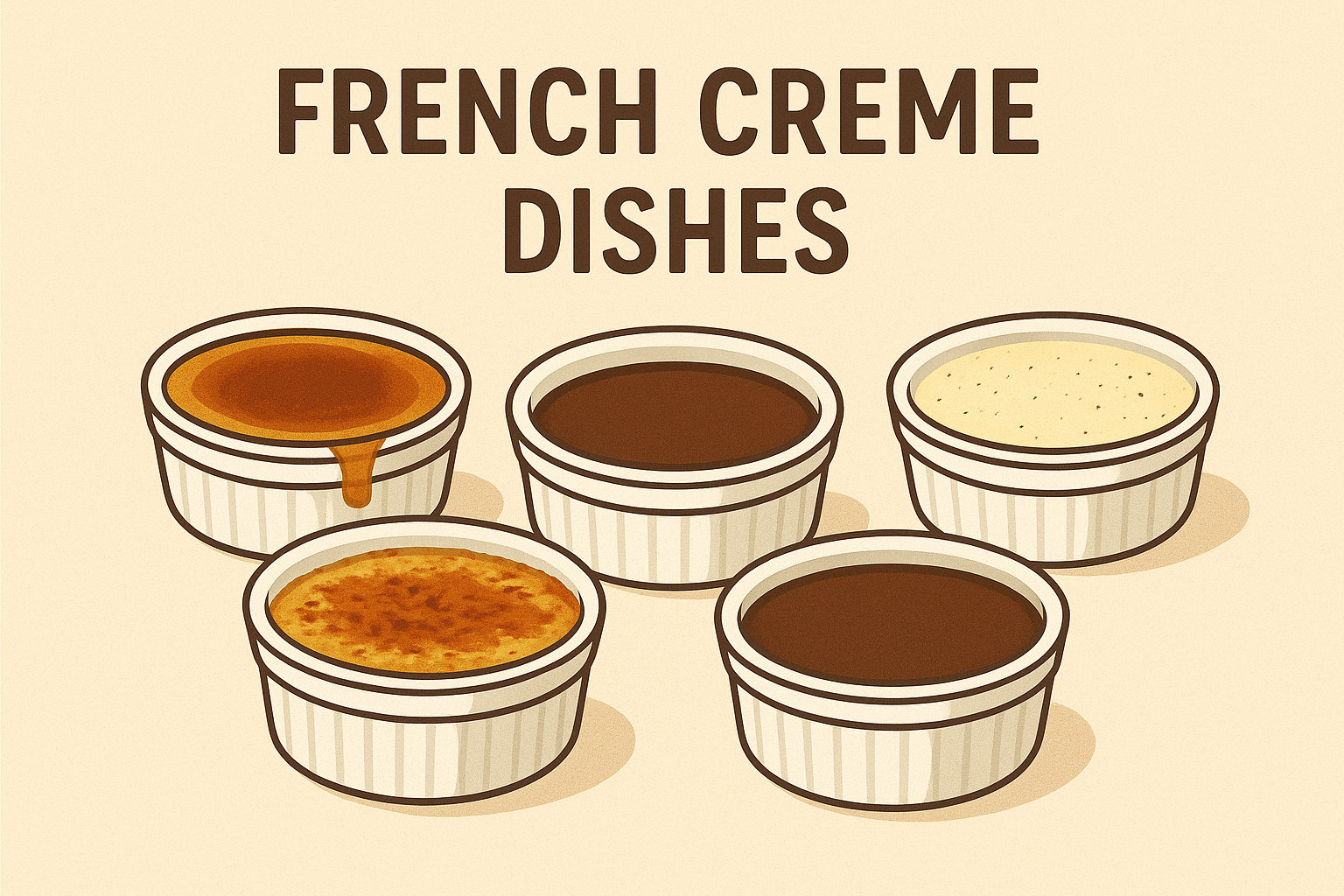
As we can see, the French word “crème” doesn’t only describe a type of dairy product — it represents a style of cooking that emphasizes smoothness, richness, and precision. These dishes are often prepared using eggs, milk, sugar, and real cream, cooked gently to achieve a velvety consistency.
14. The Role of “Crème” in Global Culinary Branding
Beyond traditional French cuisine, the term “crème” has become a symbol of refinement in international culinary branding. Restaurants, bakeries, and cafés across the world use “crème” in their menu names to sound more elegant — even when the dishes are not authentically French.
- Example 1: “Crème Delight Café” — a common name for dessert shops that use the word “crème” for appeal.
- Example 2: “Crème Dream Pastry” — bakery products using the accent mark to suggest luxury or imported quality.
In reality, many of these dishes contain regular dairy cream or synthetic substitutes. Yet, by including “crème” in their branding, businesses create a psychological connection to French luxury — similar to how perfume brands use French names to evoke class and heritage.
15. Comparing “Cream” and “Crème” in Food Preparation
To clearly understand the difference between “cream” and “crème” in cooking, let’s look at a comparison:
| Aspect | Cream | Crème |
|---|---|---|
| Origin | English | French |
| Meaning | The fatty part of milk used in food or cosmetics | Used for French-style custard or cream-based dishes |
| Texture | Thick or whipped dairy product | Soft, smooth, custard-like texture |
| Common Examples | Whipped cream, heavy cream, sour cream | Crème brûlée, crème caramel, crème pâtissière |
| Usage in Food | Ingredient in desserts, sauces, and beverages | Main element in French-style desserts and sauces |
16. How Culinary Terms Evolve Across Cultures
Over time, many French culinary terms have been adopted into English. “Crème” is one of the most common examples. Today, chefs around the world use French words to name dishes, sauces, or styles of cooking — even if the recipes have evolved or adapted locally.
This blending of languages and culinary traditions shows how food vocabulary travels with culture. What started as a purely French term has now become part of the global food identity, symbolizing richness, finesse, and artistry.
17. Cultural Symbolism of “Cream” and “Crème”
Words often carry cultural meanings beyond their dictionary definitions. “Cream” and “crème” are excellent examples of how language reflects class, heritage, and emotion. In English culture, “cream” is associated with richness, comfort, and homeliness — like a cup of coffee with cream or a bowl of strawberries and cream. It evokes warmth and familiarity.
On the other hand, “crème” is linked to elegance, art, and French sophistication. It’s not just about taste or texture — it represents refinement, exclusivity, and luxury. This distinction is deeply rooted in global perceptions of French craftsmanship, which are often associated with beauty, perfume, cuisine, and high culture.
18. Misuse of “Crème” in Modern Branding
In today’s global marketplace, many brands use “crème” purely for visual and emotional appeal. You’ll find this word printed on everything — from skincare products and perfumes to biscuits and chocolates. However, the presence of the accent mark doesn’t guarantee authenticity, quality, or even French origin.
For instance, a locally manufactured body lotion might be labeled as “Hydrating Crème de Luxe,” while its ingredients are no different from an inexpensive store cream. Similarly, a packet of “Crème Cookies” may contain synthetic fillings rather than real dairy cream. This linguistic manipulation influences customer psychology, making ordinary products appear premium.
Why This Misuse Matters
- It creates false expectations among consumers.
- It allows companies to charge higher prices without improving product quality.
- It dilutes the cultural and linguistic value of genuine French “crème” products.
19. Recognizing Real vs Fake “Crème” Branding
To distinguish between authentic “crème” products and marketing gimmicks, consumers need to observe a few key indicators. Real French-style or imported products often mention:
- The country of origin (like “Made in France” or “Product of France”).
- Authentic certifications or quality seals.
- Clear and transparent ingredient lists.
- Simple, informative packaging rather than over-decorated boxes.
In contrast, fake or misleading “crème” products rely on glamour, foreign-looking fonts, and excessive claims like “instant whitening,” “miracle glow,” or “24K gold crème.” Such products usually focus more on presentation than performance.
20. Common Mistakes in Daily Language
Many people use “crème” interchangeably with “cream,” assuming they mean the same thing. While they are related, they are not identical. Here are some common examples of confusion:
- Writing “creme” without the accent — which changes pronunciation and meaning.
- Using “crème” for English dishes that are not French in origin.
- Calling every luxury moisturizer a “crème,” even if it’s not French-formulated.
To use the terms correctly, remember this rule:
Use “cream” for English or general products, and “crème” for authentic French-style names, recipes, or products inspired by French traditions.
21. Quick Recap: Cream vs Crème Comparison
| Category | Cream | Crème |
|---|---|---|
| Language Origin | English | French |
| Pronunciation | /kriːm/ (long “ee” sound) | /krɛm/ (short “e” sound) |
| Meaning | Thick dairy or skincare product | French-style cream, custard, or luxury product |
| Usage | In English recipes, daily speech, cosmetics | In French dishes, luxury products, branding |
| Common Misuse | Used correctly in most English contexts | Overused in marketing for false luxury appeal |
22. Frequently Asked Questions (FAQ)
Q1. Is “crème” just the French word for “cream”?
Yes, “crème” is the French translation of “cream.” However, in English, it’s used selectively for French-inspired dishes or products.
Q2. Are all “crèmes” better than regular creams?
No. The quality of a product depends on its ingredients and formulation, not the language on its label. Some “crèmes” are purely marketing tactics.
Q3. Can artificial “crème” products be harmful?
Yes, many synthetic “crème” cosmetics contain parabens, petroleum compounds, or bleaching agents that can damage skin with long-term use.
Q4. How can I know if a “crème” is genuine?
Check for transparent ingredient details, authentic certifications, and real French origin labeling. Avoid over-glamorized packaging.
Q5. Why do companies prefer the word “crème” over “cream”?
Because “crème” sounds luxurious and foreign, which helps brands market their products as premium or high-end even when they are not.
23. Conclusion: The True Difference Between Cream and Crème
The difference between “cream” and “crème” goes beyond spelling. It’s a reflection of language, culture, and perception. While “cream” is simple, familiar, and essential in both food and beauty industries, “crème” represents elegance, artistry, and the influence of French refinement.
However, consumers must be aware that not every “crème” is genuine or safe. Many modern brands exploit the charm of foreign words to sell ordinary or even harmful products at premium prices. Knowledge and awareness are the best tools to avoid being misled.
In short — enjoy the richness of true cream, appreciate the artistry of authentic crème, and never fall for marketing illusions that disguise simplicity as sophistication.
